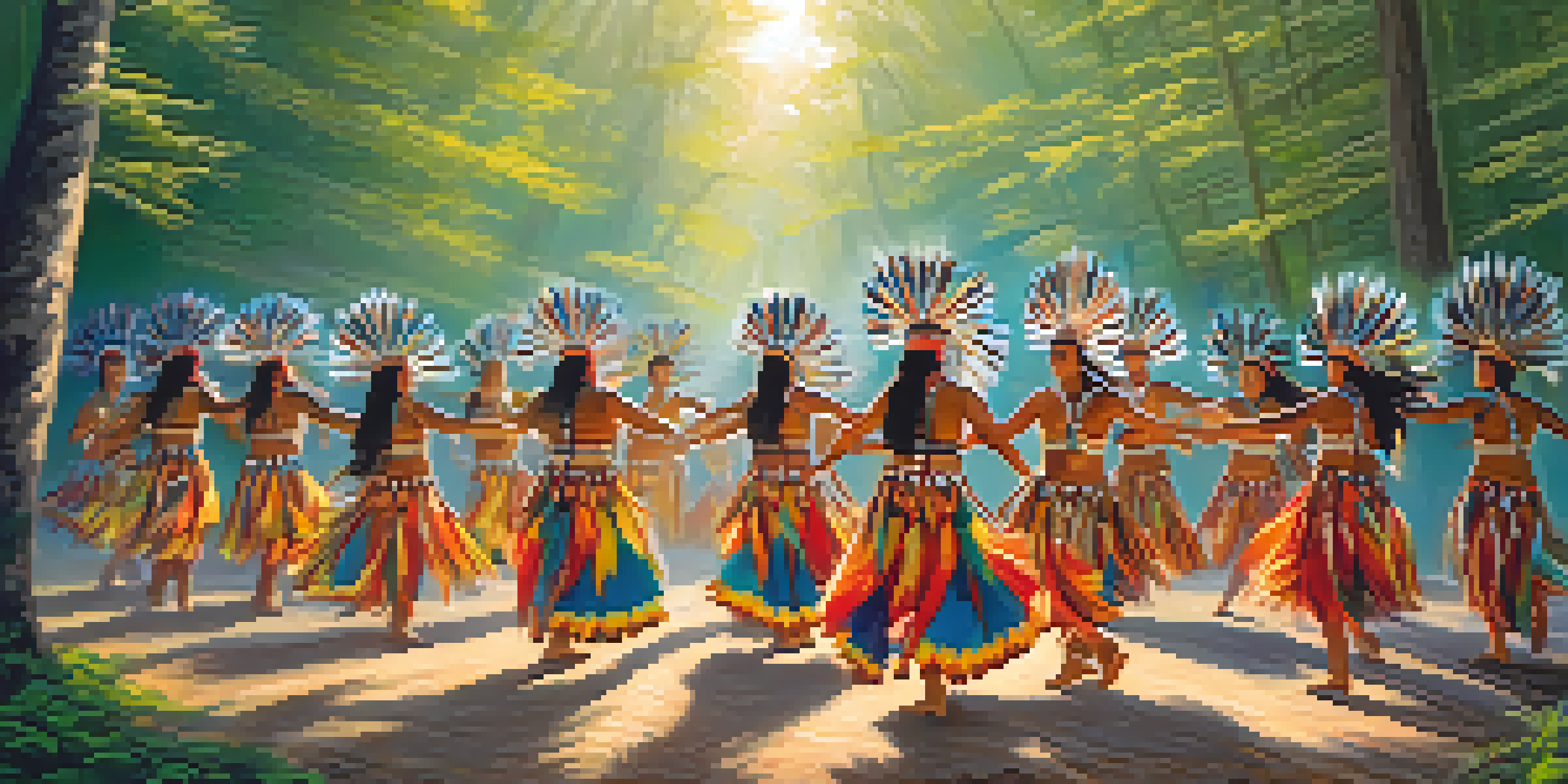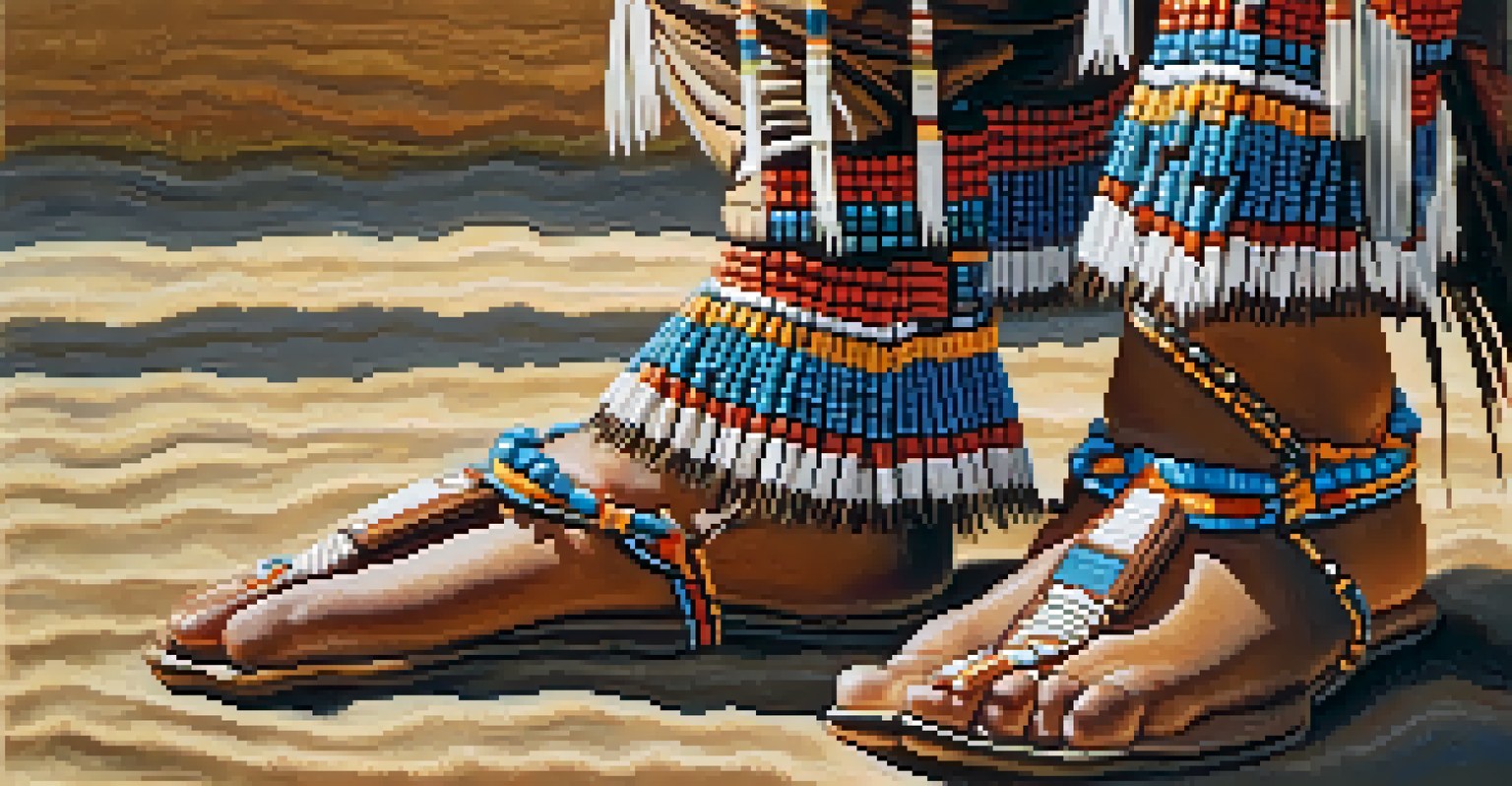Exploring the Role of Dance in Native American Healing Rituals

Understanding the Connection Between Dance and Healing
In Native American cultures, dance is not merely a form of expression but a vital component of healing rituals. It embodies the spirit and intentions of the community, fostering a deep connection between individuals and the universe. Through rhythm and movement, dancers can channel energies that promote physical, emotional, and spiritual well-being.
Dance is the hidden language of the soul.
Healing dances often reflect the beliefs and stories of the tribe, creating a shared experience that unites participants. This communal aspect amplifies the healing effects, as the collective energy of the group enhances individual intentions. By dancing together, participants reinforce their bonds with one another and the spiritual world.
For many tribes, dance is seen as a form of prayer and a way to communicate with ancestors and spirits. Each movement can symbolize a specific prayer or intention, making the dance a profound ritual that transcends mere physical activity. This intricate relationship between dance and healing highlights the importance of cultural practices in fostering overall health.
The Role of Specific Dances in Healing Practices
Different tribes have unique dances, each serving distinct healing purposes. For example, the Sun Dance is a powerful ritual among Plains tribes, where participants undergo physical trials to seek healing and vision. This dance is not only a personal journey but also a communal event, inviting support and energy from the entire tribe.

Similarly, the Healing Dance, prevalent in various Native American cultures, focuses on restoring balance to an individual's spirit. This dance often involves traditional songs and storytelling, creating a rich tapestry of cultural heritage that reinforces the healing process. The use of traditional instruments enhances the experience, grounding participants in their ancestry.
Dance as Healing in Native Cultures
Dance serves as a vital healing practice in Native American cultures, connecting individuals with their community and the spiritual realm.
These dances are often accompanied by specific rituals, such as smudging with sage or using sacred objects, to enhance their spiritual significance. These practices are steeped in tradition, ensuring that the essence and effectiveness of the healing dance remain intact across generations. The interplay between movement, music, and ritual creates a holistic healing environment.
The Spiritual Significance of Dance in Healing
At the heart of many Native American healing dances lies a profound spiritual significance. These dances serve as a bridge connecting the physical and spiritual realms, allowing participants to access deeper levels of consciousness. By engaging in dance, individuals can tap into the wisdom of their ancestors and the energy of the universe.
The body says what words cannot.
Many tribes believe that illness can stem from spiritual imbalances, and dance is a way to restore harmony. The rhythmic movements and chants are thought to invoke spirits who can aid in the healing process. This spiritual dimension underscores the belief that healing is not just a physical endeavor but a holistic journey encompassing mind, body, and spirit.
Furthermore, the act of dancing can be a form of catharsis, enabling individuals to release emotions and traumas. This release is often crucial for healing, as it allows participants to confront and process their pain in a supportive environment. By intertwining spirituality with movement, Native American healing dances cultivate a transformative experience.
The Influence of Nature on Dance Rituals
Nature plays a significant role in shaping Native American dance rituals, reflecting the profound connection these cultures have with the earth. Many dances are performed outdoors, often at sacred sites that hold cultural and spiritual importance. This connection to nature enhances the healing experience, as participants draw energy from their surroundings.
For instance, dances may be timed with seasonal changes, aligning rituals with natural cycles. The Spring Dance, for example, celebrates renewal and growth, while the Winter Dance honors introspection and rest. By synchronizing their practices with nature, tribes reinforce their beliefs in the interconnectedness of all living things.
Nature's Influence on Dance Rituals
Many Native American dances are deeply intertwined with nature, reflecting the significance of the earth and its elements in their healing practices.
Additionally, the elements—earth, water, fire, and air—often feature prominently in the dances. Symbolic movements may represent these elements, reminding participants of their relationship with the natural world. This deep respect for nature not only enriches the dance but also reinforces the importance of ecological balance in the healing process.
Dance as a Tool for Community Building
Beyond individual healing, dance serves as a powerful tool for community building in Native American cultures. Healing rituals often involve the entire tribe, fostering a sense of belonging and collective strength. This communal aspect reinforces social ties, which are essential for emotional and mental well-being.
The act of coming together to dance creates a shared purpose, helping individuals feel supported and connected. In times of crisis or grief, these communal dances can provide solace and a sense of hope. They remind participants that they are not alone in their struggles, as everyone is part of a larger community.
Moreover, dance rituals often carry educational components, passing down cultural knowledge and values to younger generations. Through participation, youth learn the significance of their heritage and the importance of supporting one another. This transmission of culture through dance helps ensure the continuity of traditions and strengthens community bonds.
Modern Adaptations of Traditional Healing Dances
As society evolves, so too do the healing practices of Native American tribes. Many communities are adapting traditional dances to fit contemporary contexts, allowing them to remain relevant while preserving their cultural significance. This evolution reflects a dynamic tradition that honors past practices while embracing the present.
For example, some tribes now incorporate modern music and dance styles into their healing rituals, creating a fusion that resonates with younger generations. This adaptation not only keeps the traditions alive but also invites broader participation from diverse audiences. The blending of old and new fosters a sense of inclusivity and relevance.
Modern Adaptations of Healing Dances
Contemporary adaptations of traditional healing dances allow Native American tribes to keep their cultural practices relevant while embracing modern influences.
However, it’s essential that these adaptations are done respectfully, maintaining the core spiritual and cultural values of the original dances. Tribes are mindful of the significance of their practices, ensuring that modern influences do not overshadow their ancestral roots. This careful balance allows the healing power of dance to thrive in today's world.
The Future of Dance in Native American Healing Practices
Looking ahead, the role of dance in Native American healing practices continues to be significant. As more people become aware of the therapeutic benefits of dance, there is a growing interest in these traditional practices. This increased visibility can help preserve and revitalize cultural heritage, ensuring that these dances are passed down through generations.
Additionally, the integration of dance into holistic health practices is gaining traction in broader wellness communities. By recognizing the power of movement as a form of healing, there is potential for greater appreciation and understanding of Native American traditions. This can foster cross-cultural exchanges and promote healing on a larger scale.

Ultimately, the future of dance in Native American healing lies in a delicate balance between tradition and innovation. By honoring ancestral practices while embracing contemporary influences, tribes can continue to use dance as a powerful tool for healing and community building. The enduring legacy of these rituals serves as a testament to the resilience and adaptability of Native American cultures.